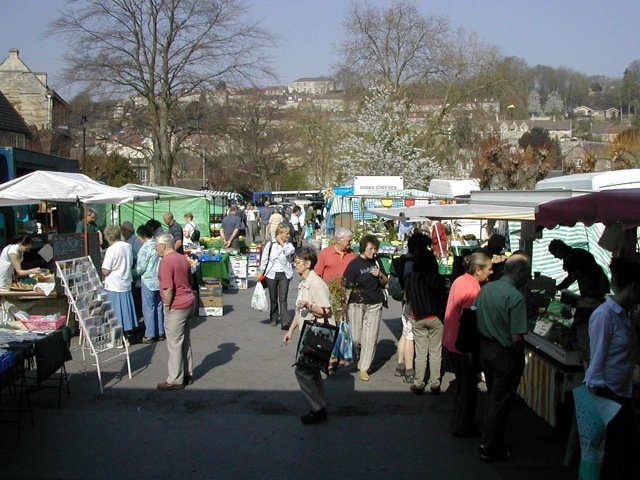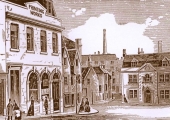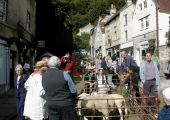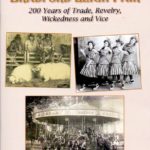.
Markets & Fairs
Bradford on Avon, Wiltshire

Bradford on Avon Market Day
Until the Middle Ages passed and even later, shopping was done at temporary markets to which certain residents had the right to set up stalls. Shops gradually came into being as stalls became permanent structures and houses.
In the Domesday Book survey of 1086 Bradeford was described as having a market that produced 45 shillings a year in taxes. The town had several market officials in the medieval period and there are records of stallholders. The Lord of the Manor, who was the Abbess of Shaftesbury Abbey in the Middle Ages, gained tolls on goods sold in the market. In 1882 Sir Charles Hobhouse, then Lord of the Manor of Bradford, sold his rights and tolls of the markets and fairs to the Bradford Town Commissioners for £250.

The centre of Bradford on Avon in 1924
The most likely location of Bradford’s medieval market is the triangular area enclosed by the Shambles, Silver Street and the lower part of Market Street. The Tolsey or market house, with 15th century doorway, still stands at the eastern end of the Shambles, becoming a public house (the Royal Oak) and now a shop. Next to it was the old town hall, which became derelict until it was demolished in the 1820s. The area where Silver Street, Coppice Hill and Mill Street (now Kingston Road) meet was known as the Market Place. In the early 19th century the market was moved to the other end of the Shambles and Pippet Street was renamed Market Street.
A weekly market was started again in the 1980s and is held in the Bridge Street car park, administered by Wiltshire Council until devolved to Bradford’s Town Council in 2022. Other markets- farmers’ and artisans’ markets are held and an annual “street market” is held in Westbury Gardens in July.
In 1280 the Abbess of the time gained the right to hold a fair on the Feast of the Trinity, the Sunday following Pentecost (the 50th day after Easter) in May or June, but at some time it came to be held on the Monday, rather than the Sunday. Trinity Fair was held between the Market Place and the Court House in Church Street and centred around sales of cattle and eventually across the Town Bridge and up St Margaret’s Street. By the end of the 18th century it was dwindling and had been wound up by 1907. Outside the town, in a part of Bradford Leigh still known as Fairfield, an unchartered fair grew up from the 1750s and became one of the largest in the county. Bradford Leigh Fair was held over the days of the Feast of St Bartholomew, 29th August. It changed over the years from an agricultural market into more and more of a funfair, until it closed in 1956.
In 1252 an annual fair that was held in Holt on St Catherine’s day was licensed to Robert de Holt, the Lord of the Manor of Holt.
A funfair was held for a while at Culver Close in the town and now Jennings’ funfair visits a field near the former Beehive Inn, Trowbridge Road from time to time.







